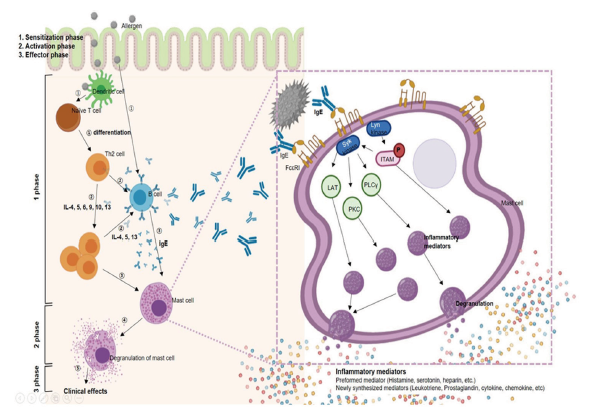Abstract
Many people in the world are suffering from various allergy-related diseases, such as allergic conjunctivitis, rhinitis, asthma, and anaphylaxis, caused by the pollen grains of weeds. More than thirty percent of the population in Korea is reported to have been suffering from pollen allergies. Despite their adverse effects on public health, little is known about allergic weeds and their distribution in Korea. The authors introduce the mechanism of action of allergies, the domestic weeds that cause allergies and their distribution in Korea, and the implications of the allergy-causing weeds. Most of allergies are caused by the pollen from the flower of weeds, e.g.,
Figures & Tables

Fig. 1. An allergic reaction that occurs when pollens of weeds enter the human body. ① Allergens are delivered to T helper 2 (Th2) cells by dendritic cells (DCs) or directly stimulate B cells. ② Th2 cells secrete IL-4, 5, 6, 9, 10, and 13 to stimulate B cells or form Th2 complexes, and Th2 complexes also excessively secrete IL-4, 5, and 13 to stimulate B cells. ③ IgE secreted by the Th2 complex and stimulated B cells activates mast cells and induces degranulation of mast cells. IgE acts on the IgE high affinity receptor (FcεRI) on the surface of mast cells. When two or more FcεRIs are linked in a stable form by an allergen, Lyn kinase and Syk kinase are activated. Lyn kinase phosphorylates ITAM (immunoreceptor tyrosine-based activation motif) and acts on syk kinase or induces accumulation and degranulation of inflammatory substances in mast cells. In addition, Syk kinase also activates LAT, PKC, and PLCγ. to induce accumulation of inflammatory substances in mast cells and degranulation. ④ Inflammatory mediators accumulated in mast cells are secreted out of the cells through degranulation. ⑤ Th2, B cells, and mast cells are stimulated again by the secreted inflammatory mediators, causing a transient reaction and developing clinical symptoms


